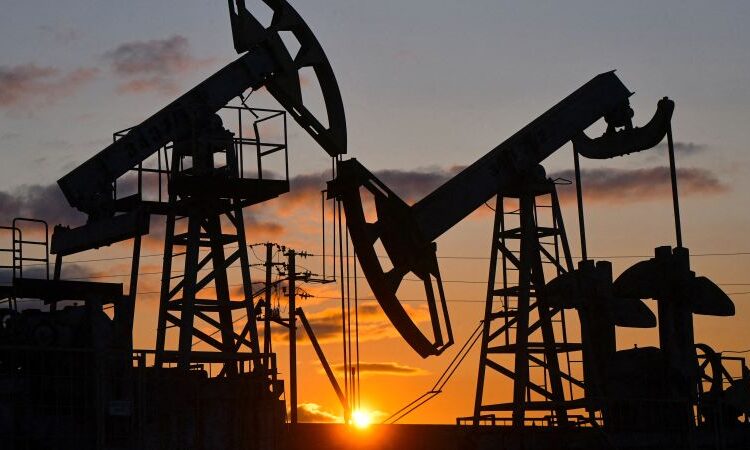
Alexander Manzyuk/Reuters
Russia is exporting as much oil now as it did before its full-scale invasion of Ukraine. It’s just selling to different buyers.
London
CNN
—
After the pandemic and war in Ukraine, and the inflation shock that followed, the global economy is in a precarious state. The last thing it needs right now is another nasty surprise.
That’s what it nearly got this weekend as disaffected Russian mercenaries marched toward Moscow, drawing a stark warning from President Vladimir Putin that the country was on the brink of a 1917-style “civil war.”
The armed insurrection has been defused — for now — but the most serious challenge to Putin’s authority in 23 years could still usher in a period of turmoil and change.
“Putin has total chaos now,” Yale professor and Russia expert Jeffrey Sonnenfeld told CNN.
Russia has dropped out of the ranks of the top 10 economies in the world, with a gross domestic product roughly the size of Australia’s, but it remains one of the biggest suppliers of energy to global markets — including China and India — despite Western sanctions imposed in the wake of its full-scale invasion of Ukraine in February 2022.
On Saturday, a fellow global energy power, Qatar, expressed “great concern” about the situation in Russia.
“The escalation of the situation in Russia and Ukraine will have negative repercussions on international security and peace, as well as on food and energy supplies,” Qatar’s foreign ministry said in response to news of the rebellion.
Any meaningful loss of Russian energy would force China and India to compete with Western nations for supplies from other producers. If political chaos restricts exports of other commodities, such as grains or fertilizer, that could also send supply and demand out of whack. And that could push up prices for everyone.
Richard Bronze, head of geopolitics and co-founder at Energy Aspects, said markets would now need to figure out the extent to which prices should rise to reflect the greater risk to Russian supply, a view shared by other analysts.
“This seemingly attempted coup only brings uncertainty, which could be reflected through into higher prices,” Matt Smith, lead Americas oil analyst at Kpler said. “Such upheaval and uncertainty as we have seen in recent days could bring support to prices given the potential for supply disruptions — and the fear of them — that wasn’t a consideration prior to the weekend.”
Global energy and food prices shot up in the wake of last year’s invasion of Ukraine, turbocharging inflation in Europe and the United States. It has fallen from multi-decade highs since, but the battle to control prices is not over and is now in a decisive phase.
“The last leg of the journey to restore price stability will be the hardest,” the Bank for International Settlements — the bank for central banks — said in its annual report Sunday.
There was a “material risk that an inflation psychology will take hold,” leading to what economists describe as a wage-price spiral, it said.
“The global economy is at a critical juncture. Stern challenges must be addressed,” general manager Agustin Carstens told the annual general meeting of the BIS in Basel.
Signs that global energy demand could weaken this year as economies slow have pushed US crude prices down by nearly 14% so far this year to just under $70 a barrel. (It peaked above $120 a year ago.) The international benchmark — Brent crude — is down by a similar margin.
But anything that could jeopardize Russia’s ability to keep supplying global energy markets will be watched anxiously by policymakers in the West, and by the country’s biggest customers in Asia.
“If anything … disrupts those flows, then that would definitely be a an upside risk for oil prices, particularly as we’re already moving into a part of the year when global demand for oil is expected to significantly exceed supply,” Bronze said.
Libya and Venezuela provide cautionary tales of how civil war and internal political strife can savage energy exports. Libya’s oil production dropped from about 1.7 million barrels per day to a record low of just 365,000 in 2020, according to the US Energy Information Agency. Venezuelan production also hit a multi-decade low that same year, according to analysis by the Council on Foreign Relations.
Russia is a much more important player. At just under 10 million barrels per day, it produces about 10% of global crude oil demand. And with total oil exports of nearly 8 million barrels per day, Russia is the second biggest power by a wide margin after Saudi Arabia in the OPEC+ alliance of leading energy producers.
Western sanctions have had the desired effect of reducing the amount of money Moscow earns from energy, but Russia’s oil exports — in volume terms — have rebounded to levels seen before it invaded Ukraine as China and India mop up barrels shunned by G7 nations.
Bronze, at Energy Aspects, was cautious about drawing parallels with Libya and Venezuela. A better comparison would be the immediate aftermath of the fall of the Soviet Union. It took a long time for the Russian oil industry to recover from that.
“You had real issues in terms of investment and real issues in terms of stability in the oil sector, which had already been heavily damaged in the last years of the Soviet Union,” he added.
Sonnenfeld told CNN that the risk that Russian upheaval could ripple out to weaken the global economy had fallen over the past 18 months. The Ukraine war had backfired by forcing Europe to pivot to alternative sources, he added.
Though it is too early to say anything will happen or change, “this is by no means over, and so it does raise new questions about what might follow,” Bronze said.
— Sarah Diab and Sharon Braithwaite in London, and Alexandra Peers and Ramishah Maruf in New York, contributed to this article.






